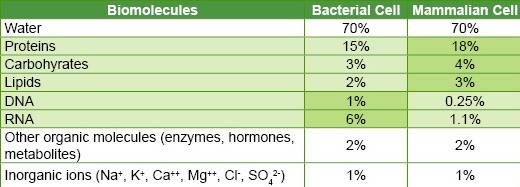Memorize the Proportion of Biomolecules in Bacterial and Mammalian Cells in 3 Easy Steps!
Are you looking for an easy way to memorize the proportions of biomolecules in bacterial and mammalian cells?
Whether you are an MDCAT aspirant or an FSc Intermediate student, you will find these tricks useful in memorizing the table given in the book. I have experience of almost three years with MDCAT so, I will be able to explain better than anyone out there. Without any fluff, Let’s get started.
Table of Contents
Types of biomolecules
There are two types of biomolecules which are as follows:
- Organic biomolecules
- Inorganic biomolecules
Organic biomolecules
The biomolecules in which carbon and hydrogen are covalently bonded to each other (C-H) are called organic biomolecules. This consists of four biomolecules which are as follows:
- Carbohydrates
- Proteins
- Lipids
- Nucleic Acid (DNA & RNA)
If you have difficulty remembering them, we have a mnemonic, especially for you. Cricket is a very popular sport in Pakistan and India. You should have heard of CPL which is a cricket tournament that takes place in West Indies. You can remember them by NCPL which is the first letter of each biomolecule.
NCPL = New Caribbean Premier League
Inorganic biomolecules
The biomolecules which do not contain covalently bonded C-H bonds are called inorganic biomolecules. This consists of all molecules other than organic molecules and their derivatives. Some examples of inorganic biomolecules are given below:
- Water
- Gases like CO2 and O2
- Acids, bases and salts
The proportions of biomolecules in various cells are different. The proportions of biomolecules in bacterial and mammalian cells are given in the table below:

Memorize this table
Now, you are going to learn the easiest trick to remember the table. Just follow these simple steps:
- First of all, see the types of biomolecules. Proteins, carbohydrates, lipids and nucleic acids are organic biomolecules and others are inorganic biomolecules (include other organic molecules in inorganic because they are in very low proportions)
- Secondly, remember that only the proportions of organic biomolecules are different in both cells (highlighted by light green colour in the table). While the proportions of inorganic biomolecules are the same in both cells.
- Thirdly, the proportions of proteins, carbohydrates and lipids are higher in mammalian cells and only the proportions of nucleic acids are higher in bacterial cells (the proportions higher are highlighted by dark green in the respective cell).
Quick Recap
- Organic biomolecules are NCPL
- Inorganic biomolecules are water, gases, acids, bases and salts
- In the table, these were the memorizing techniques:
- Highlighted in light green = Have different proportions in both cells
- Highlighted in dark green = Higher proportions in the respective cell
Conclusion
In this article, you have learned the types of molecules and an impressive technique to learn the table of proportions between bacterial and mammalian cells. We hope you find this useful and share it with your friends. Finally, make sure to tell us in the comments if you have a better technique to learn this table. We’d appreciate your effort.
JOIN THE FACEBOOK GROUP
Join the community of MDCAT aspirants and keep learning new stuff from your fellow aspirants. When you are with like-minded people you always grow. You grow when you share your knowledge with others.
